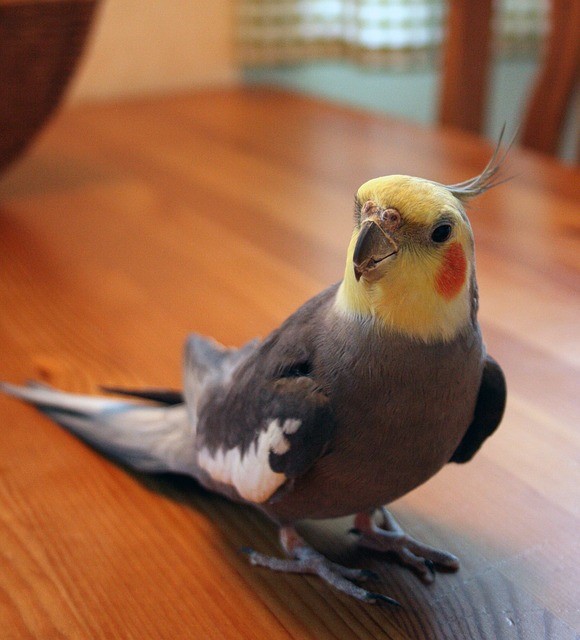There are lots of different cockatiel colors and mutations including Pied, Pearl, Cinnamon, Whiteface, Pearl face and more.
Below is a list of the most popular color mutations for cockatiels.
Cockatiel Colors
Normal Grey
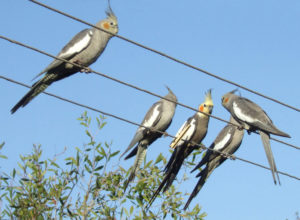
As the name suggests this is where it all began. In the wild, in Australia, cockatiels are to this day the normal grey color. These birds are grey throughout with some light colours on their wings, yellow face and orange spot on their cheeks. The males are brighter in color then the females. You can see a few females and males in the picture of the small flock of wild birds.
Because this bird has no mutation it is a strong and healthy bird. This bird is the original and contains all the genetic information that all the other colours/mutataions have. The first mutation, the pied coloured cockatiel, didn’t happen until around 100 years of captivity, appearing in California in 1951.
Pied Color
‘Pied’ is referring to the ratio of light to dark feathers. The pied coloured cockatiels have darker eyes and lighter legs compared to the normal grey. Some of the pied cockatiels also hold a dark talon or a whole toe. The pied colors have different degrees or heaviness.
Our ‘Nebel’ is a heavy pied cockatiel. Here’s a pic of her. She also has a little pearling going on too.
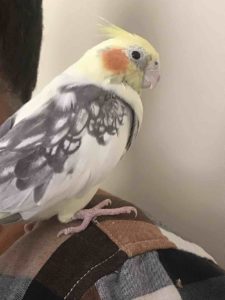
A clear pied is a cockatiel lacking all the melanin (colour) from its feathers. Pied cockatiels have dark eyes compared to a lutino which have red eyes. An ordinary pied carries clear areas of white or yellow, with flashes of grey in some areas. A heavy pied carries a lot of melanin free areas, about 75% of its feathers, while a light pied cockatiel is dark and has only a couple of light flight feathers. Here’s how the Australian National Cockatiel Society categorises light and heavy pied cockatiels and other mutations.
Pearl Color

The Pearl Cockatiel is a very distinct bird with beautiful pearling on their feathers. If breeding for the perfect pearl cockatiel the colors pattern should not be lacking from any melanin on its back and it should be thick and clear. The bright yellow pearling should be bright and the grey parts ideally dark grey so to well define the pearling.
Cinnamon Color
Cinnamon is a cooler shade of grey. The color varies depending on how much yellow there is under the melanin coverage. Cinnamon also has beige feet and beak, dark ruby eyes and the common yellow face with orange patch. According to the native cockatiel society of Australia, the cinnamon coloured cockatiel was first seen in Western Australia in the bush, in 1984.
Parblue or Partial Blue Cockatiels
The Parblue Cockatiels have varying degrees of mutation of the gene that affect the amount of yellow visible in the bird, which largely effects the face. The 3 variations or Parblue are the Whiteface, Paleface and Creamface cockatiel. Here’s a link to 3 great pics of all the parblue birds.
Whiteface Color
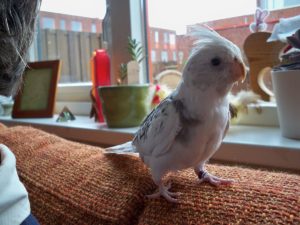
This cockatiel’s colors, along with the paleface and cream face are actually caused by the “blue” mutation. With the Whiteface Cockatiel all red and yellow shades will be completely lacking because the blue color affects the psittacine pigment. This means that where the bird would normally be yellow or red, it will be white. They have a mostly white or greyish face and no orange or yellow. This mutation appeared in Holland first in 1964.
Paleface Color
The paleface, also known as the pastelface cockatiel, remains the wild-type grey but the psittacine pigment makes all the red and yellow tones much paler. A more pastel type colouring.
Creamface Color
This colour of cockatiel is between the whiteface and the pastelface. While the whiteface mask has a very pale, tepid cheek patch, the creamface cockatiel has a very beautiful cockatiel color but with a lighter shade of white than the pastelface, where the mutation affects the yellow and red pigments.
Goldcheek Color
This color has a high rate of early chick mortality. They are said to be lousy parents – especially the hens that seem to be lazy both in brooding and taking care of the chicks. The goldcheek is similar to the yellow-cheek but its cheek color has a stronger contrast. The goldcheek hens tend to exhibit cock-like behavior.
Olive Color
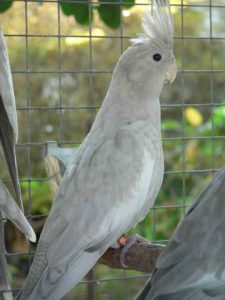
The olive color cockatiel has light grey feathers with a greenish appearance caused by a yellow tinge. The mutation may also occur in a brownish mustard tone. The feathers have a beautiful pattern.
Lutino Color
Lutino, also known as Ino, are a popular color and were the 2nd mutation appearing in the US. Lutinos have white to light yellow feathers and the common orange patch on the cheek.
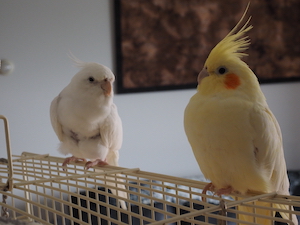
Many breeders have created different color mutations to make their brood unique so the list is growing every year. If you are interested in breeding cockatiels click here.
With all the different cockatiel colours and mutations there is sure to be one that you like!
Here’s a super fast video (2 mins) with pictures of some of the most common mutations.
For those interested in going deeper and considering breeding, below is a very in depth video on colours, mutations and genetics (40 mins).
What are your favourite cockatiel colors?
More links on Cockatiel Colors
A good pic with lots of varieties
Australian National Cockatiel Society
Native Cockatiel Society of Australia
Brisbane Cockatiels

